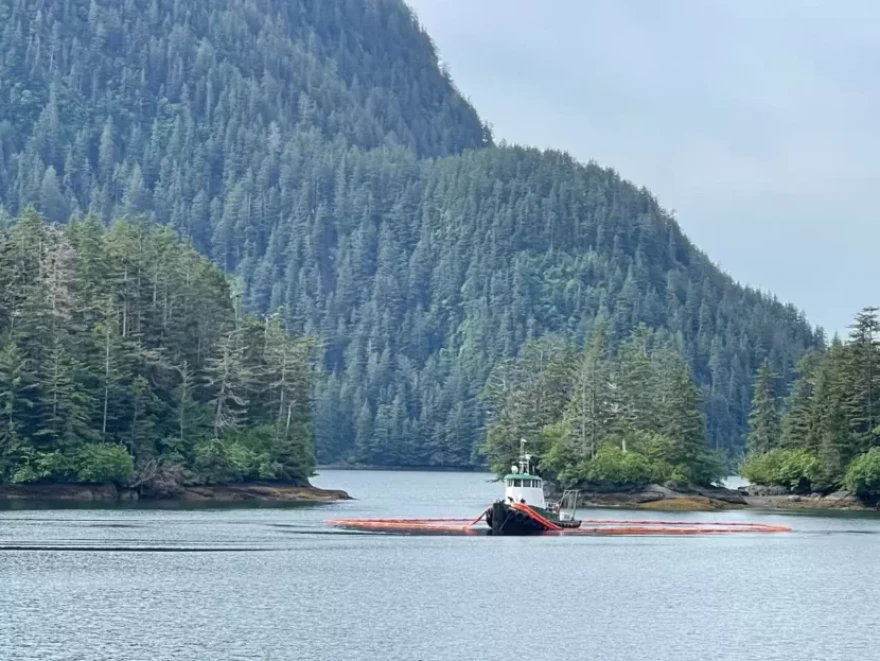On June 9, a mariner fouled his anchor in Herring Cove. Every time he tried to move the anchor, a little oil sheen and debris would pop up.
“He called us to check and make sure that there wasn’t any known debris in the area, and to try to see if there was a known snag,” said Petty Officer First Class Heather Darce in an interview with KCAW. Darce is a marine science technician with the Coast Guard’s Marine Safety Detachment in Sitka.
“We were able to check local charts,
Darce says the mariner then hired a local diver to help retrieve his anchor. In doing so, the diver discovered a sunken boat, an 80-foot wooden vessel, attached to a smaller boat. The boat’s sinking hadn’t been reported to the Coast Guard. But they were able to find its vessel number and name.
“So the Dragon Lady is the last name that she held, but the boat was actually built in the ’40s and went through a bunch of different iterations,” Darce said.
The Coast Guard immediately hired a marine salvage crew to contain the oil and figure out if it was purging any more oil– and it wasn’t. So Darce says they began to research the boat to figure out where its fuel tanks might be so they could dive down and remove the fuel safely. They found the builder, Wheeler, in Brooklyn, New York, and requested diagrams of the boat.
“They didn’t have anything that old, but they did go ahead and let us know that that hull number corresponded to a vessel that was built by them in 1943 for use by the United States Coast Guard,” Darce said.
“That sort of changed…things on a little bit of an emotional level for us, knowing that, as Coasties, that this was a Coast Guard Cutter.”
Wheeler built over 230 patrol boats for the Coast Guard during World War 2. According to the Wheeler Yacht Company, 48 of them were at Omaha Beach on D-Day. Before the Dragon Lady got her name, Darce said she was Coast Guard Cutter 83482.
“The military was basically pumping out equipment to get it to the frontlines as fast as possible,” Darce said. “And none of the 238 cutters that were built by Wheeler during those years were actually named, they were given a hull number.”
Darce said they dove deeper into the history of the cutter, and discovered the vessel was delivered to Guam in 1943.
“Her delivery would have taken place prior to the Battle of Guam, which happened in summer of 1944,” Darce said. “So she very well have maintained on that service during the Battle of Guam.”
After the war was over, Coast Guard Cutter 83482 was decommissioned and turned into a private craft. She was in Portland for a while, was used as a fishing vessel and brought to Alaska, sold again to become the Dragon Lady, a charter yacht, and eventually became a liveaboard toward the end of her life.
It’s unclear exactly when the Dragon Lady sank — it had been anchored in Herring Cove for a while. Darce said they were able to contact the boat’s owner who wasn’t in the area when it began taking on water, but the owner has been cooperating with the Coast Guard. But salvaging the boat isn’t in the cards.
“Even if somebody really wanted to bring up the Dragon Lady, she’s a wooden hulled vessel built in the ’40s. She’s been underwater for a significant period of time, and she’s 80 years old,” Darce said. “So even if for some reason we could not get to the tanks, in her case she’s not necessarily a good candidate even to try to move or roll, especially with her size.”
Darce doesn’t believe there’s much fuel on the boat, but a dive team has been diligently working to remove any remaining fuel to prevent future environmental risk. Once they’ve emptied the vessel and sealed up vents, Darce said they’ll update charts to show Herring Cove as the resting place for the Dragon Lady.



